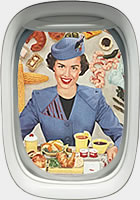The Nostalgia Problem
 For some unfathomable reason, people who would never believe today’s advertising will accept yesterday’s without question.
For some unfathomable reason, people who would never believe today’s advertising will accept yesterday’s without question.
Take air travel. Passengers yearn for the “golden age” of air travel. When that golden age took place remains unclear. Maybe the 1950s. Maybe the 1960s. Perhaps even the 1970s. And hey, the 1980s had a lot going for them too. But everyone agrees the golden age ended long ago.
Of course, this “golden age” sprang as much from advertising as anything else. Reality fades away. Perceptions last.
Advertising like this 1950s ad for TWA exemplifies the golden age: A smiling stewardess finds herself completely surrounded by food. Bread. Corn on the cob. Ham. A whole turkey. It all looks delicious. And if you had somewhere to go in the 1950s, you probably couldn’t have afforded it. This ad sells first-class service because, at the time, coach did not exist. Airlines didn’t introduce economy class until 1957. Before that, everyone flew first or, more likely, they didn’t fly at all.
Take a look at this ad from the late 1960s:
This commercial makes flying look swell. But commercials sell things. That’s what they do. Reality doesn’t always measure up. Read this New York Times Letter to the Editor from 1968:
I recently boarded a 100-passenger plane in Boston. The seats were so small that they were actually uncomfortable, and I am not a large person. We were served two small hot meatballs in a cup, and either free soft drinks or liquor to be paid for. Using the same airline about two weeks before, we were served crackers and peanuts…
If the price of what the airlines call “food” and/or “snacks” is included in the fare, I think perhaps everybody traveling would much prefer to do without the so-called “food” or “snacks” and have a corresponding reduction in the rate.
Some will protest that airlines have eliminated “meals” and “snacks” without reducing the rate. But they have. Air fares have fallen 40 percent since shortly after deregulation. Lower fares mean more people can fly — from 197 million on passengers U.S. carriers in 1975 to 677 million in 2010. No stewardesses will carve a roast beef right in front of those passengers, but they will get where they want to go — cheaper, faster, and far more safely.
Airline food has always tasted terrible. The seats have always seemed small, at least in coach. Just as today’s airline advertising glosses over air travel’s challenges, so did airline advertising in the so-called “golden age.”
Modern airlines still tout their delicious food, their comfortable seats, their friendly service. But the public holds them to a strange double standard. Today passengers compare airlines not only against each other, but against a mythical past created in large part by advertising.
Maybe airlines branded themselves too well.
